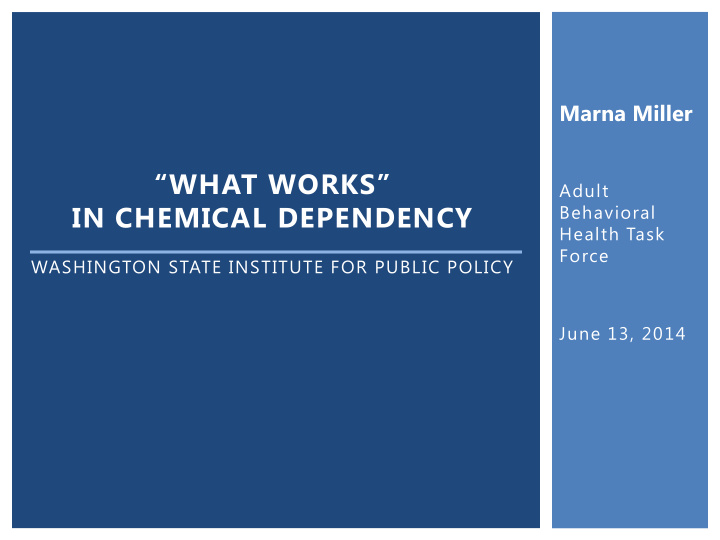



Marna Miller “WHAT WORKS” Adult IN CHEMICAL DEPENDENCY Behavioral Health Task Force WASHINGTON STATE INSTITUTE FOR PUBLIC POLICY June 13, 2014
Washington State Institute for Public Policy Legislative direction, 2SSB 5732 (2013 session) • By May 15, 2014: Prepare an inventory of evidence-based, research-based, and promising practices for prevention and intervention services. Consult with the DSHS, the University of Washington Evidence- Based Practice Institute, the University of Washington alcohol and drug abuse institute, and the Washington institute for mental health research and training . • By August 1, 2014, DSHS must use the inventory to develop a behavioral health improvement strategy and report the strategy to the governor and legislature. http://www.wsipp.wa.gov June 13, 2014 Slide 2 of 8
Washington State Institute for Public Policy Our Approach: As we have done in other policy areas: Systematic review of all available studies on a topic • Meta-analysis to determine the average effect of • the program on outcomes of legislative interest Benefit-cost analysis to determine whether lifetime • benefits exceed the program cost Classify programs as evidence-based, research- • based, or promising on the definitions in SSSB 5732 http://www.wsipp.wa.gov June 13, 2014 Slide 3 of 8
Washington State Institute for Public Policy Definitions in SSSB 5732: Evidence-based practice A program or practice that has been tested in heterogeneous or intended populations with multiple randomized, or statistically controlled evaluations, or both; or one large multiple site randomized, or statistically controlled evaluation, or both, where the weight of the evidence from a systemic review demonstrates sustained improvements in at least one outcome. "Evidence-based" also means a program or practice that can be implemented with a set of procedures to allow successful replication in Washington and, when possible, is determined to be cost-beneficial. Research-based practice A program or practice that has been tested with a single randomized, or statistically controlled evaluation, or both, demonstrating sustained desirable outcomes; or where the weight of the evidence from a systemic review supports sustained outcomes as described in subsection (14) of this section but does not meet the full criteria for evidence-based. Promising practice A practice that, based on statistical analyses or a well-established theory of change, shows potential for meeting the evidence-based or research-based criteria, which may include the use of a program that is evidence-based for outcomes other than those listed in subsection (14) of this section (defining “evidence - based”.) http://www.wsipp.wa.gov Slide 4 of 8 June 13, 2014
Washington State Institute for Public Policy The Inventory: Reason Program Does Level of Cost- Percent Program/Intervention Manual Not Meet Evidence- Evidence beneficial Minority Based Criteria Early inte terven venti tion on (at-ri risk drinking g and d subst bstance use) Brief Alcohol Screening and Intervention for College Yes Yes (75%) Heterogeneity 15% Students (BASICS): A Harm Reduction Approach Brief Intervention in primary care Yes Yes (94%) 24% Brief Intervention in emergency department Yes Yes (78%) 79% Brief Intervention in medical hospital Yes No (73%) Benefit-cost 54% Treatm tments ts for subst bstance abuse se or depende dence 12-Step Facilitation Therapy Yes No (63%) Benefit-cost 48% Anger Management for Substance Abuse and Mental Research on outcomes of Yes P N/A N/A Health Clients: Cognitive-Behavioral Therapy interest not yet available Key: Evidence-based ˜ Research-based ž Produces null or poor outcomes P Promising http://www.wsipp.wa.gov Slide 5 of 8 June 13, 2014
Example: a treatment that works & is cost-beneficial Washington State Institute for Public Policy Methadone maintenance therapy (10 studies): • Synthetic opioid that blocks the effects of opiates, reduces withdrawal symptoms, and relieves cravings. • Dispensed in outpatient treatment clinics Primary outcome from the studies • Reduces opioid use -- while client is in treatment Benefit-cost findings: • Benefit-cost ratio: $3.50 of benefits per dollar of cost. • We estimate the benefits exceed the costs 99% of the time Classification: • Evidence-based http://www.wsipp.wa.gov Slide 6 of 8 June 13, 2014
Example: a program that is not cost-beneficial Washington State Institute for Public Policy Primary care in behavioral health settings (11 Studies): Co-location of primary care in mental health and substance abuse • treatment centers Outcomes from the study: Small increase in primary care visits • Non-significant reductions in emergency room, hospitalization, • blood sugar, blood pressure, cholesterol Benefit-cost findings: • Benefit-cost ratio: $1.22 of benefits per dollar of cost. • We estimate the program will break even 50% of the time Classification: • Research-based (not evidence-based) http://www.wsipp.wa.gov Slide 7 of 8 June 13, 2014
THANK YOU Questions? The inventory report is available at: http://www.wsipp.wa.gov/ReportFile/1558/Wsipp_Inventory-of-Evidence- based-Research-based-and-Promising-Practices-Prevention-and- Intervention-Services-for-Adult-Behavioral-Health_Report.pdf June 13, 2014 Slide 8 of 8 http://www.wsipp.wa.gov
Recommend
More recommend